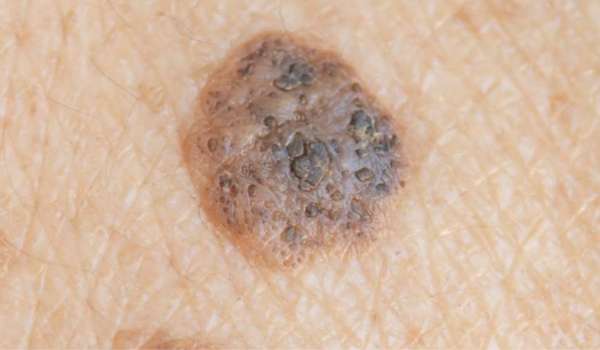You might be wondering how to tell the difference between seborrheic keratosis vs. melanoma. Although these two skin conditions can often look very similar to each other, it is important to be able to tell them apart. Seborrheic keratosis is a common, benign skin growth that can appear as you age. It may seem worrisome at first because it can resemble a wart, pre-cancerous skin growth (actinic keratosis), or skin cancer, but seborrheic keratosis is rarely cause for concern. Melanoma, on the other hand, is the most serious kind of skin cancer.
Despite their similar appearance, seborrheic keratoses is a harmless growth, whereas melanoma requires immediate medical attention if spotted. The good news is that dermatologists treat these and many other medical dermatology conditions quite frequently, and the chances of curing melanoma and other forms of skin cancer are higher the earlier it is discovered.
What Are the Symptoms of Seborrheic Keratosis?
Seborrheic keratosis can appear anywhere on the skin, except the palms and soles of your hands and feet. Most often, you’ll find seborrheic keratosis growths on the chest, back, head, or neck. However, they can appear anywhere on your skin, except the palms and soles. They usually appear as a tan or brown color, but they can range in color from white to black. The name of this condition is derived from its appearance. Seborrheic means “greasy” and keratosis means “thickening of the skin.” Some growths may have a warty surface, while others look like dabs of warm, brown candle wax on the skin.
Seborrheic keratoses are not contagious. They have no relationship to skin cancer and do not pose a risk to your health. Unlike moles, they never turn into melanoma. Occasionally, they become inflamed or irritated, causing pain and itching. Avoid scratching or picking at seborrheic keratoses, or you may develop an infection.
Most people get seborrheic keratoses when they are middle aged or older. They’re often called the “barnacles of aging” because they begin at a later age and can have a wart-like appearance. Usually people prone to seborrheic keratosis will develop several growths, although it is possible to have just one.
What Are the Symptoms of Melanoma?
Another big difference between seborrheic keratosis vs. melanoma is that melanoma is a type of skin cancer that can begin as a mole or wart. It’s the most serious type of skin cancer and can spread to other areas of the body.
Melanoma can have a variety of appearances. On some people, a melanoma skin growth may look very similar to seborrheic keratosis. If you have a history of seborrheic keratosis, you may not notice melanoma in its early stages if you’re accustomed to unusual skin growths.
Seborrheic keratoses and melanoma are not easy to distinguish, but a dermatologist may be able to tell the difference based on a physical examination. In some cases, however, it is necessary to take a biopsy of the growth to check for cancer under a microscope.
How to Tell Seborrheic Keratosis from Melanoma
Although the two skin conditions can look very similar to one another and vary in appearance, there are typically some key differences to note. Melanoma most often appears as a solitary growth, rather than a cluster, and it is usually smoother in texture. By contrast, seborrheic keratosis often appears in numbers, tends to have a more scaly texture, and usually maintains a defined border and uniform shape and color. Seborrheic keratosis also is slower to change, unlike melanoma, which can grow or change more abruptly and is more likely to have an inconsistent border shape or color.
Despite these common trends, both seborrheic keratosis and melanoma can appear in many forms. If you’re concerned about any skin growths, you should not try to self-diagnose your condition or assume that a new skin growth is benign. If any new skin growths develop you should see your dermatologist, especially if the growth changes over time, or if you have a family history of skin cancer.
Regular Skin Checks can Help Minimize Risk of Skin Cancer
Regular skin checks are an important part of staying aware of your health and reducing your risk of skin cancer, especially if you are already prone to seborrheic keratosis. Even though existing seborrheic keratosis growths cannot become cancerous, keeping a close eye on your skin and seeing your doctor frequently will reduce the likelihood of mistaking melanoma for just another seborrheic keratosis growth. You should see your dermatologist annually for a skin and mole check to help reduce the risk of developing skin cancer. We recommend monthly head-to-toe self-skin exams and frequent skin cancer screenings in our office for early detection.
Do you have a growth that may be concerning to you? Schedule an appointment with us today by filling out our form below. Our team of highly trained, board-certified dermatologists at Vujevich Dermatology will examine it for you. We will also discuss the recommended frequency of self-examinations and in-office skin cancer screenings, and help you take any further precautionary steps after examination.
Vujevich Dermatology Associates offers medical, surgical, and cosmetic dermatology from some of the most highly trained physicians and clinicians in the greater Pittsburgh area. You can reach our team at 412-429-2570 or visit our contact page to see all of our locations. You can also follow us on Facebook to see what’s new in the world of dermatology.

